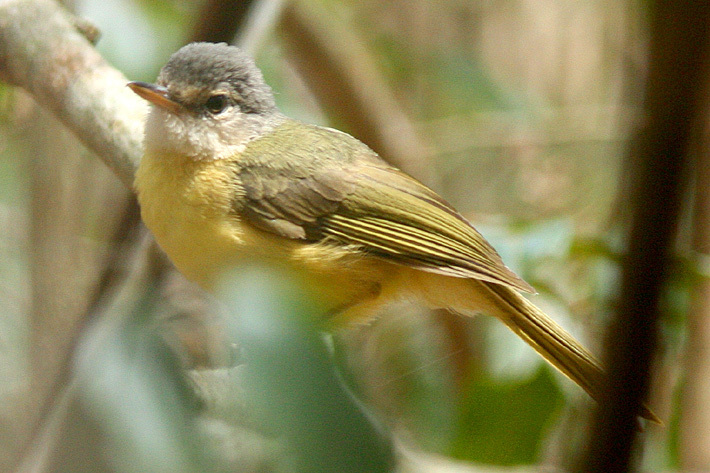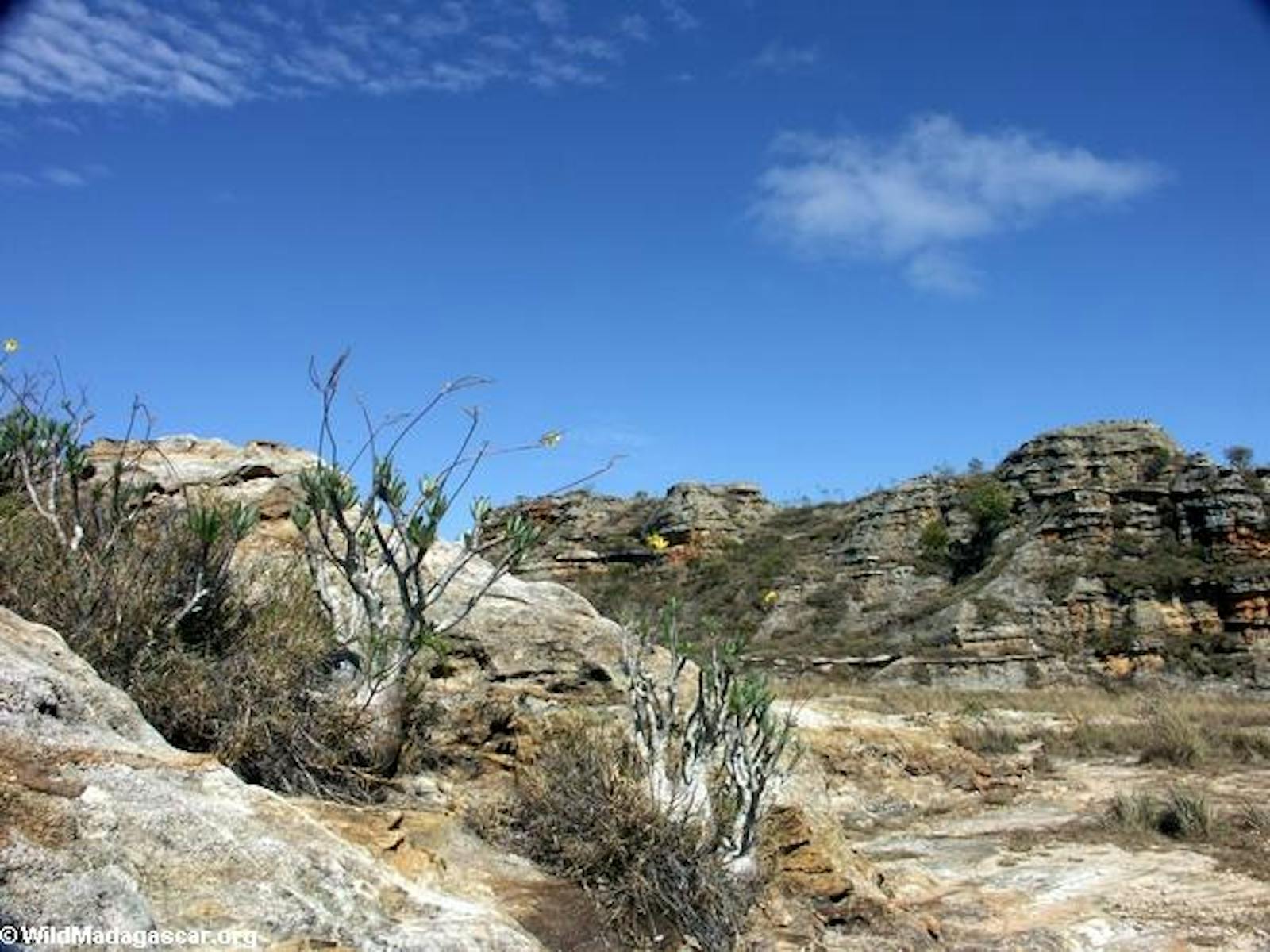Madagascar Succulent Woodlands
The ecoregion’s land area is provided in units of 1,000 hectares. The protection goal is the Global Safety Net (GSN1) area for the given ecoregion. The protection level indicates the percentage of the GSN goal that is currently protected on a scale of 0-10.
Bioregion: Madagascar Island (AT6)
Realm: Afrotropics
Ecoregion Size (1000 ha):
7,987
Ecoregion ID:
100
Conservation Target:
9%
Protection Level:
3
States: Madagascar
During times of food shortage, bat bushmeat, such as the Madagascan flying fox, is an important source of protein for the Malagasy people. Although bat hunting is only allowed during the national bat hunting season, the restriction is often disregarded. As a consequence, bat populations are seriously threatened by overhunting, particularly as fruit bats only produce one offspring per year. Other species threatened by hunting are the tailless tenrec, the straw-colored fruit bat, and the red-fronted brown lemur.

The flagship species of the Madagascar Succulent Woodlands ecoregion is the Appert’s greenbul.
The ecoregion is located in southwestern and central western Madagascar, sandwiched between the Madagascar Spiny Thickets and the Madagascar Dry Deciduous Forests. The terrain is relatively flat, but there are some notable rocky outcrops and deep precipitous valleys (e.g., in the Makay region). The ecoregion has a tropical dry climate with a distinct dry season between May and October. During the wet season, November to April, rainfall may reach 750 mm, within a yearly range of 575 mm to 1,330 mm. The annual average daily temperature for the region is between 25º and 31ºC.
The ecoregion’s vegetation is similar to the Madagascar Dry Deciduous Forests but is characterized by more xerophytic species. These species often have water storage adaptations, stem photosynthesis, and remain without leaves for long periods. Forests of the ecoregion may reach 15 m in height, with the endemic baobabs, Adansonia za, and Adansonia grandidieri, as distinctive emergent species. Other canopy species belong to the families Euphorbiaceae and Leguminosae, including several endemic species of Pachypodium. The shrub layer consists of the families Sapindaceae, Euphorbiaceae, Anacardiaceae, and Burseraceae.

Madame Berthe's mouse lemur. Image credit: FC Casuario, Creative Commons
This ecoregion provides important habitat for eight species of lemurs and 60 to 90 species of birds. There is an overlap of species between the succulent woodlands and the spiny thicket to the south, as well as the dry deciduous forests to the north. The Ambalibe Menabe area is of particularly high biodiversity importance with exceptional levels of wildlife endemism. There are also several areas of high local endemism, for example, the forests between the Tsiribihina and Mangoky Rivers and around the National Park of Zombitse-Vohibasia.
Endemic mammals include narrow striped mongoose, the giant jumping rat, and Berthe’s mouse lemur.
Near-endemics include the red-tailed sportive lemur, large-eared tenrec, lesser hedgehog tenrec, and Verreaux’s sifaka. Among the birds, Appert’s greenbul is strictly endemic, known from the Zombitse-Vohibasia forests. The following additional species are near-endemic: white-breasted mesite and long-tailed ground-roller. The red-capped coua is found throughout this ecoregion. Some of the local endemic reptiles include the Madagascan collared iguana and the banded day gecko.
Spider tortoise has a narrow distribution range within the ecoregion, as do Antimena chameleon and Brygoo’s leaf chameleon. The rare snake Liophidium chabaudi also occurs.
A number of protected areas fall within this ecoregion, including Zombitse-Vohibasia National Park, Isalo National Park, Vohipary and Beompa proposed protected areas, Vohibasia National Park, Andranomena Special Reserve, and Kirindy-Mitea National Park. These protected zones, as well as several classified forests, comprise a relatively small area of the remaining habitat. The classified forests offer relatively little protection as logging continues in these areas.
As with many of the habitats of Madagascar, the major threat to the succulent woodlands is fire, both intentional burning for expansion of agricultural and pasture lands and unintentional wildfires. The increased incidence of cultivation and fire in recent times has led to increasingly fragmented and isolated patches of native vegetation. Tree cutting for charcoal production has caused massive deforestation.
The Malagasy endemic tree, Hazomalania voyroni, is at risk of becoming extinct through traditional forest exploitation for construction wood. In addition to this species, there are several other endemic trees that are removed from the forests mainly for construction purposes, including Givotia madagascariensis, Cedrelopsis grevei, and Commiphora spp.
Traditional hunting occurs throughout the ecoregion, even within protected areas. With increasing human populations and greater movement of people, these traditional activities are becoming locally unsustainable. The main species threatened by hunting are the tailless tenrec, the Madagascan flying fox, the straw-colored fruit bat, and the red-fronted brown lemur. In many parts of the ecoregion, cattle and goat grazing are also degrading the forests.
Priority conservation actions for the next decade
- Strengthen programs aimed at improving the control of bushfires and implement adequate training to build people's capacity for fighting bushfires.
- Encourage the use of improved stoves to efficiently manage the use of fuel and prevent extensive charcoal production and fuel wood collection.
- Rehabilitate degraded ecosystems within and outside protected areas.
-
-
1. Burgess, N., Hales, J.A., Underwood, E., Dinerstein, E., Olson, D., Itoua, I., Schipper, J., Ricketts, T. and Newman, K. 2004. Terrestrial ecoregions of Africa and Madagascar: a conservation assessment. Island Press.
2. CEPF. 2014. Ecosystem Profile: Madagascar and Indian Ocean Islands. [Online]. [Accessed 25 April 2018]. Available from: https://www.cepf.net/sites/default/files/ecosystemprofile_madagascar_en.pdf
3. Rabarison, H., Randriamahaleo, S.I., Andriambelo, F.M., and Randrianasolo, H.L. 2015. National Biodiversity and Action Plans 2015-2025. Madagascar: Ministry of the Environment, Ecology, Sea and Forests.
4. Jenkins, R.K. and Racey, P.A. 2008. Bats as bushmeat in Madagascar. Madagascar Conservation & Development. 3(1). -
Cite this page: Madagascar Succulent Woodlands. Ecoregion Snapshots: Descriptive Abstracts of the Terrestrial Ecoregions of the World, 2021. Developed by One Earth and RESOLVE. https://www.oneearth.org/ecoregions/madagascar-succulent-woodlands/
-




